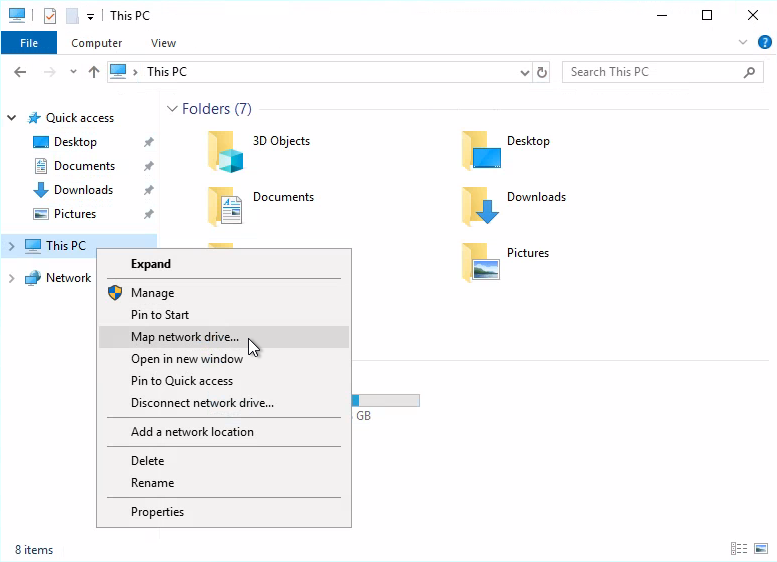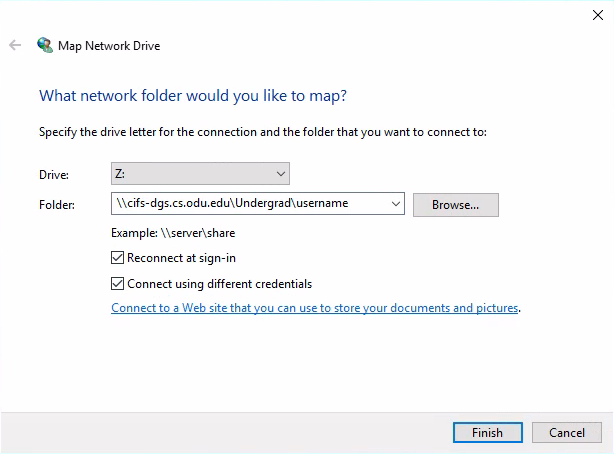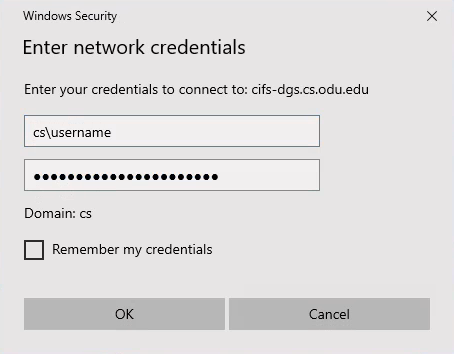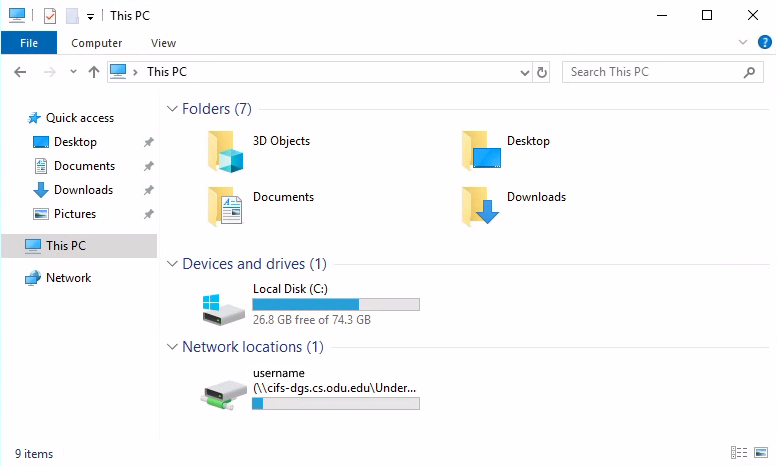Difference between revisions of "Remote Access for Z Drives"
From Systems Group
| Line 1: | Line 1: | ||
| − | As noted [[Windows Z Drive| here]], all | + | As noted [[Windows Z Drive| here]], all faculty, staff, and students have a network storage share allocated for their CS account. These drives are seamlessly integrated on Computer Science desktops and servers, but to access them at home some extra steps must be taken. |
== Windows == | == Windows == | ||
| Line 46: | Line 46: | ||
# Connect to the CS VPN. Instructions on doing so can be found [[Remote Access & VPN | here]]. | # Connect to the CS VPN. Instructions on doing so can be found [[Remote Access & VPN | here]]. | ||
# From the Go menu/ Mac OS X Finder, select "Connect to Server" | # From the Go menu/ Mac OS X Finder, select "Connect to Server" | ||
| − | # Type in your unix network path from the table below prepended by <code>smb:</code>For example: | + | # Type in your unix network path from the table below prepended by <code>smb:</code>. For example: |
#: <pre>$ smb://cifs-dgs.cs.odu.edu/Undergrad/$YOUR_USERNAME</pre> | #: <pre>$ smb://cifs-dgs.cs.odu.edu/Undergrad/$YOUR_USERNAME</pre> | ||
#: Be sure to replace <code>$YOUR_USERNAME</code>. | #: Be sure to replace <code>$YOUR_USERNAME</code>. | ||
Revision as of 21:16, 14 April 2020
As noted here, all faculty, staff, and students have a network storage share allocated for their CS account. These drives are seamlessly integrated on Computer Science desktops and servers, but to access them at home some extra steps must be taken.
Windows
- Connect to the CS VPN. Instructions on doing so can be found here.
- Open Windows File Explorer either by right clicking the “Start” button and selecting “File Explorer” or by pressing
⊞WIN + E - Right click “This PC” and select “Map network drive…”
- Type the network path (folder) of your drive, select “Connect using different credentials,” and click “Finish.” If you don’t know the network path of your drive, see the table below. Be sure to replace “username” with your CS username:
- Enter your CS account credentials with the username prepended by “cs\” and click “OK”
- Your Z drive should now be connected. Note that it will not be available if you disconnect from the VPN.
Linux
SSHFS
SSHFS is a filesystem client that uses SFTP over SSH to securely provide file access. Because of SSH's existing security, using SSHFS does not require our VPN if our public Linux servers are used as the host.
- Install
sshfsfrom your distribution's package manager - Create a directory to mount the share over:
-
$ mkdir ~/zdrive
-
- Mount the share; rather than use a network path, SSHFS uses a server followed by the directory's path on that server. For example:
-
$ sshfs $YOUR_USERNAME@linux.cs.odu.edu:/home/$YOUR_USERNAME ~/zdrive
- Be sure to replace
$YOUR_USERNAME. -
-
- To unmount the share:
-
$ fusermount -u ~/zdrive
-
CIFS
Note that this method will require super user privileges. If you are not a privileged user, see SSHFS above.
- Connect to the CS VPN. Instructions on doing so can be found here.
- Install the
cifs-utilspackage from your distribution's package manager - Create a directory to mount the share over:
-
$ sudo mkdir /media/zdrive
-
- Mount the share using your network path from the table below. For example:
-
$ sudo mount -t cifs -o username=$YOUR_USERNAME,uid=$YOUR_UID //cifs-dgs.cs.odu.edu/Undergrad/username /media/zdrive
- Be sure to replace
$YOUR_USERNAMEand$YOUR_UID. -
-
- To unmount the share:
-
$ sudo umount /media/zdrive
-
MacOS
- Connect to the CS VPN. Instructions on doing so can be found here.
- From the Go menu/ Mac OS X Finder, select "Connect to Server"
- Type in your unix network path from the table below prepended by
smb:. For example:-
$ smb://cifs-dgs.cs.odu.edu/Undergrad/$YOUR_USERNAME
- Be sure to replace
$YOUR_USERNAME.
-
Network paths
Be sure to replace "username" with your computer science username.
| Account type | Windows network path | Unix network path |
|---|---|---|
| Undergraduate | \\cifs-dgs.cs.odu.edu\Undergrad\username |
//cifs-dgs.cs.odu.edu/Undergrad/username
|
| Graduate | \\cifs-ecs.cs.odu.edu\Grad\username |
//cifs-ecs.cs.odu.edu/Grad/username
|
| Staff | \\cifs-dgs.cs.odu.edu\Staff\username |
//cifs-dgs.cs.odu.edu/Staff/username
|
| Faculty | \\cifs-ecs.cs.odu.edu\Faculty\username |
//cifs-ecs.cs.odu.edu/Faculty/username
|



